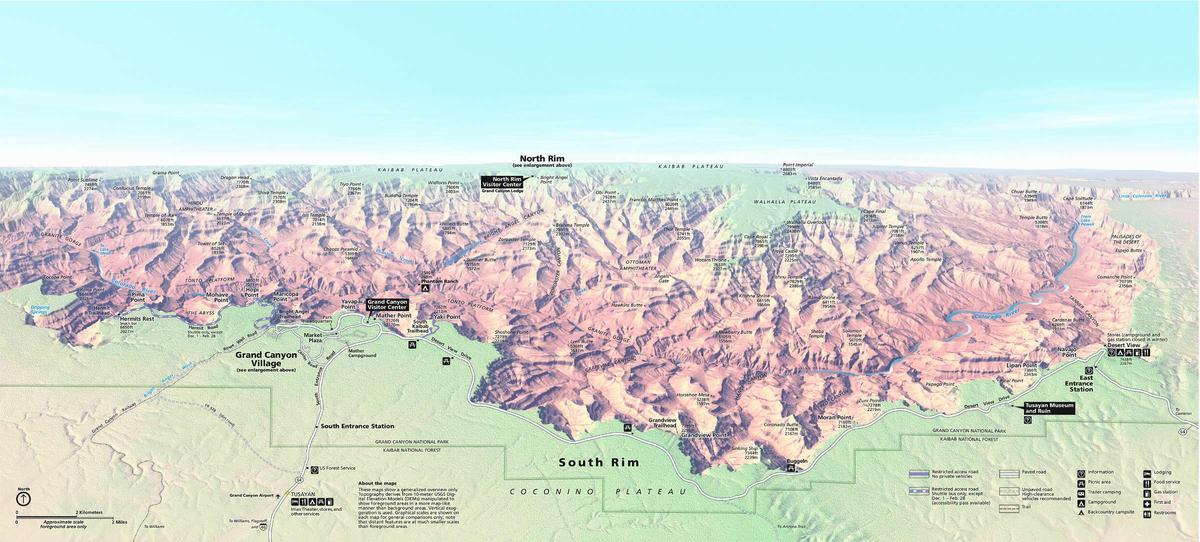Grand Canyon NP--North Kaibab Trailhead
Grand Canyon NP--North Kaibab Trailhead
North Kaibab Trail North Rim, Arizona 86052
Day Hiking - Grand Canyon National ParkNorth Kaibab Trail Information Sheet
Grand Canyon National Park website
Grand Canyon National Park maps
Tips for Birding
In-depth information is found on the Grand Canyon National Park website.
About this Location
North Kaibab Trail distance and hiking times vary. This is the only maintained trail into the canyon from the North Rim. Even a short hike to Coconino Overlook (1.5 miles / 2.4 km round-trip) or Supai Tunnel (4 miles / 6.5 km round-trip) can give you an appreciation for the canyon's rich natural beauty and immense size. A hike to Roaring Springs and back is extremely strenuous and takes a full day (7-8 hours) - begin your hike before 7 a.m. Roaring Springs lies 3,050 feet / 930 m below the canyon rim and is 9.4 miles / 15 km round-trip. A day hike beyond Roaring Springs is not recommended. Many years of experience have shown that hikers who proceed beyond this point during the hottest parts of the day have a much greater probability of suffering from heat-related illness, injury, or death. This trail is also used by mules. NOTE: Round trip to the Colorado River is 28 miles / 45 km and the trail descends almost 6,000 ft. / 1,800 m. Under no circumstances should you attempt to hike from the rim to the river and back in one day! Do not hike during the hottest part of the day.
About Grand Canyon National Park
See all hotspots at Grand Canyon National Park
Grand Canyon is considered one of the finest examples of arid-land erosion in the world. Incised by the Colorado River, the canyon is immense, averaging 4,000 feet deep for its entire 277 miles. It is 6,000 feet deep at its deepest point and 18 miles at its widest. However, the significance of Grand Canyon is not limited to its geology.
The Park contains several major ecosystems. Its great biological diversity can be attributed to the presence of five of the seven life zones and three of the four desert types in North America.
The five life zones represented are the Lower Sonoran, Upper Sonoran, Transition, Canadian, and Hudsonian. This is equivalent to traveling from Mexico to Canada.
The Park also serves as an ecological refuge, with relatively undisturbed remnants of dwindling ecosystems (such as boreal forest and desert riparian communities). It is home to numerous rare, endemic (found only at Grand Canyon), and specially protected (threatened or endangered) plant and animal species.
Over 1,500 plant, 355 bird, 89 mammalian, 47 reptile, 9 amphibian, and 17 fish species are found in the park.
Notable Trails
The North Kaibab Trail is the least visited but most difficult of the three maintained trails at Grand Canyon National Park. Almost a thousand feet higher at the trailhead than South Rim trails, hikers on the North Kaibab Trail pass through every ecosystem to be found between Canada and Mexico. At the rim, hikers will glimpse the vast maw of Bright Angel Canyon through fir trees and aspen, ferns, and wildflowers. The trail as it descends through the Redwall Limestone is blasted directly into the cliff, "literally hewn from solid rock in half-tunnel sections." Farther down, the ecology progresses so that hikers look up at the surrounding canyon walls through a blend of riparian and desert vegetation. Along the way, Roaring Springs and Ribbon Falls both offer rewarding side trips that are wonderfully juxtaposed to the often hot conditions of the main trail.
Content from Day Hiking - Grand Canyon National Park, North Kaibab Trail Information Sheet, and Grand Canyon National Park website
 Grand Canyon Panorama Map
Grand Canyon Panorama Map